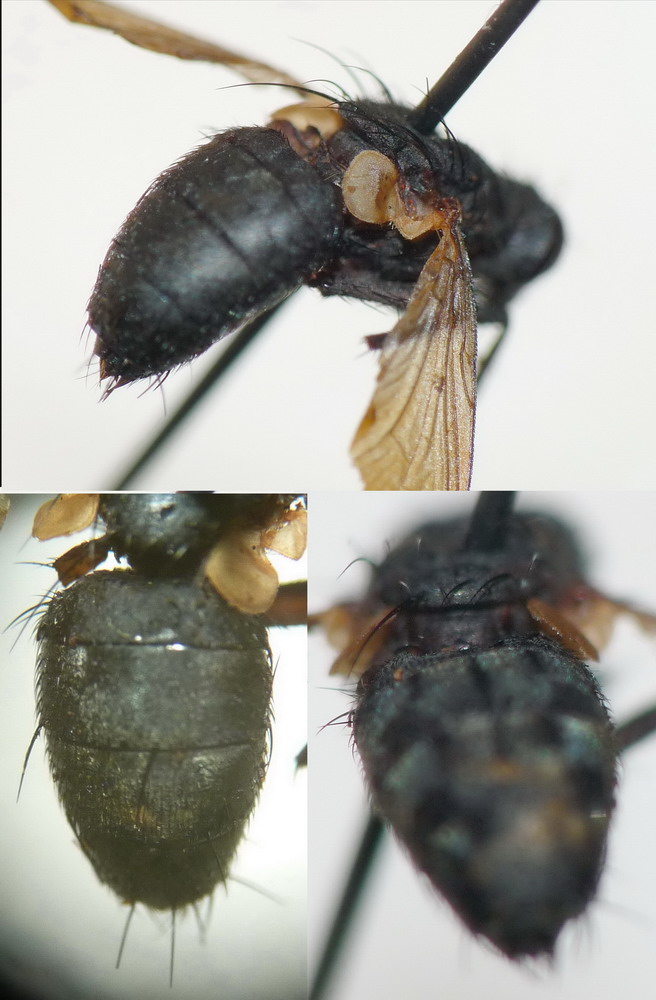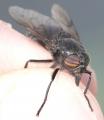Diptera.info :: Identification queries :: Diptera (adults)
Who is here? 1 guest(s)
|
Sarcophagidae (Calyptrata fly: which family?)
|
|
| rafael_carbonell |
Posted on 14-09-2012 09:43
|
|
Member Location: Beuda, Girona, Catalonia Posts: 687 Joined: 23.03.06 |
I would like help to identify this calyptera fly I thought it was tachinidae but it doesn't fit with this family following Hans-Peter Tschorsnig and Benno Herting interactive (and dichotomic) keys (but i did'nt look at all characters). Could then be Sarcophagidae? Which genera or species? Can Grau, Beuda, Catalonia, Spain, UTM31T DG7477, 395 m., found in a liquid trap, 13th july 2007. LENGHTH: 7.5 mm HEAD: eyes (apparently) bare, ocelli present; height of gena/vertical eye diameter about 0.4; width of eye/width of frons of 0.86; long proboscis; ventral and dorsal part of occiput with at least some yellowish hairs; ANTENNA: antenna longer than height of gena; arista plumose: longest hairs visibly exceeding length of basal diameter of arista; thickness of arista about 0.4 of its lenghth; THORAX: 3 postsutural intra-alar bristles, prosternum (apparently) bare; postpronotum with three or more setae: the three most robust clearly forming a triangle; WING: vein R4+5 with short setae from the base approximately to intersection with vein R-M; bend of M at a right angle (initially) and without appendix; cell R5 open at wing border ABDOMEN: terguites I and II just a bit hollowed in the anterior part (in the specimen is a bit broken); terguites 2, 3 and T4 without median discal bristles; T3 and T4 with marginal bristles; Thanks for helping (I spent three days looking at it...) rafael_carbonell attached the following image:  [179.79Kb] Edited by rafael_carbonell on 24-09-2012 23:28 |
|
|
|
| Sara21392 |
Posted on 16-09-2012 09:24
|
|
Member Location: Posts: 1445 Joined: 07.11.10 |
Maybe Muscidae???? 
Sincerely yours Sara |
|
|
|
| ChrisR |
Posted on 16-09-2012 18:59
|
|
Super Administrator Location: Reading, England Posts: 7703 Joined: 12.07.04 |
It looks a little like Sarcophagidae but really you need to start by trying to remove the grease by bathing it in acetone or ethyl acetate for a day or two. If you start with a bad specimen then you will always have difficulty identifying it 
Manager of the UK Species Inventory in the Angela Marmont Centre for UK Biodiversity at the Natural History Museum, London. |
| rafael_carbonell |
Posted on 17-09-2012 19:46
|
|
Member Location: Beuda, Girona, Catalonia Posts: 687 Joined: 23.03.06 |
Many thanks, Chris and Sara: It is not Muscidae as it has a row of setae on hypopleuron (=meron). @Chris: I will clean i as you say. Does any paint solvent work as well (if not i will buy it)? And this one is the one I could'nt get through. I have identified about 8 species new for home using Palearctic keys, but also a modern version of the interactive key: http://www.tachinidae.eu/ i will upload them just to confirm in the near future (and if not I will sent you)  |
|
|
|
| ChrisR |
Posted on 17-09-2012 21:41
|
|
Super Administrator Location: Reading, England Posts: 7703 Joined: 12.07.04 |
You just need a really good solvent but one that will not leave its own deposits, so something quite clear & volatile.
Manager of the UK Species Inventory in the Angela Marmont Centre for UK Biodiversity at the Natural History Museum, London. |
| rafael_carbonell |
Posted on 17-09-2012 22:47
|
|
Member Location: Beuda, Girona, Catalonia Posts: 687 Joined: 23.03.06 |
Thanks again, Chris, I'm learning a lot with your web content. Now I remembered I have ethyl acetate. We will see. Best wishes, Rafael |
|
|
|
| ChrisR |
Posted on 18-09-2012 07:55
|
|
Super Administrator Location: Reading, England Posts: 7703 Joined: 12.07.04 |
No problem - if my advice helps a fellow entomologist then I am happy  The worst thing you can do is try to push an identification on a very damag specimen. But in this case you might be able to see more when the grease has been removed. Some flies (particularly dexiines in my experience) exude these fatty deposits after death.w The worst thing you can do is try to push an identification on a very damag specimen. But in this case you might be able to see more when the grease has been removed. Some flies (particularly dexiines in my experience) exude these fatty deposits after death.w
Manager of the UK Species Inventory in the Angela Marmont Centre for UK Biodiversity at the Natural History Museum, London. |
| rafael_carbonell |
Posted on 21-09-2012 10:22
|
|
Member Location: Beuda, Girona, Catalonia Posts: 687 Joined: 23.03.06 |
The cleaning in ethyl acetata for two days wasn't strong enough but I see more clearly a "chess game" pattern in the abdomen. In the spanish entomology keys I use, the distance from the bend of M to the wing margin longer than that from the M bend to rm is diagnostic of sarcophagidae (but also tachinidae as the feature "shape of postscutellum" is ambiguous for me). There are two errors in the first despription: date is june nor july There are may only two postsutural intra-alar setae (the other one is in the postalar callus) Vein R4+5 with short setae from the base approximately to intersection with vein R-M (at about 0.74). With that combination of characters there is no genus in the "Interactive key to the genera of the Palaearctic Tachinidae", so now I feel a bit sure is Sarcophagidae (so now I'm happy the family is sure, and I can pin it in the correct row). If someone agrees with that i wll change the thread title. Many thanks, Rafael |
|
|
|
| ChrisR |
Posted on 21-09-2012 11:46
|
|
Super Administrator Location: Reading, England Posts: 7703 Joined: 12.07.04 |
Can you see a well-rounded subscutellum? The scutellum will project so that it fits inside the 'excavation' in tergite 1+2 but under that a tachinid would have a rounded bulge, above the next rounded part that joins onto the abdomen. See here for photos: http://tachinidae...page_id=25
Manager of the UK Species Inventory in the Angela Marmont Centre for UK Biodiversity at the Natural History Museum, London. |
| rafael_carbonell |
Posted on 24-09-2012 09:28
|
|
Member Location: Beuda, Girona, Catalonia Posts: 687 Joined: 23.03.06 |
Thanks Chris, now I think I used to confuse the subscutellum with "the next rounded part". Even in the picture is not clear, now I see the subscutellum is quite thin and flat, not bulged.
rafael_carbonell attached the following image:  [128.95Kb] Edited by rafael_carbonell on 24-09-2012 09:29 |
|
|
|
| ChrisR |
Posted on 24-09-2012 19:19
|
|
Super Administrator Location: Reading, England Posts: 7703 Joined: 12.07.04 |
Hmm, yes I don't see a subscutellum there 
Manager of the UK Species Inventory in the Angela Marmont Centre for UK Biodiversity at the Natural History Museum, London. |
| Thomas Pape |
Posted on 29-09-2012 21:47
|
|
Member Location: Natural History Museum of Denmark Posts: 110 Joined: 29.08.05 |
This is certainly a flesh fly of the subfamily Sarcophaginae, which I base on the 2 primary + 2 subprimary notopleural setae and the plumose arista with a bare distal third. Cannot say more with the condition of the specimen.
Thomas Pape |
| rafael_carbonell |
Posted on 30-09-2012 17:40
|
|
Member Location: Beuda, Girona, Catalonia Posts: 687 Joined: 23.03.06 |
Many thanks, Thomas |
|
|
|
| Jump to Forum: |













